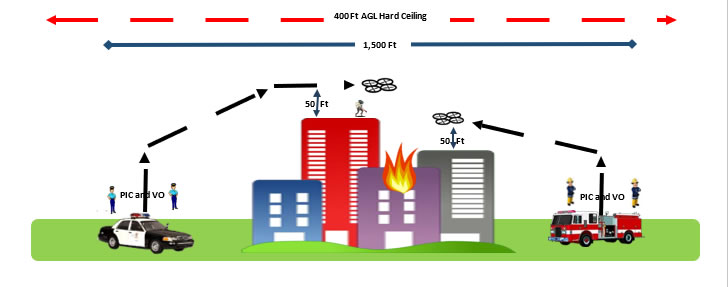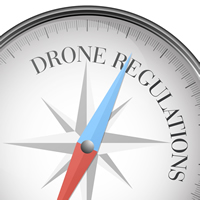
First Responder Tactical VLOS
91.113 Waiver Guide
In a time of extreme emergencies to safeguard human life, first responders require the capability to operate their unmanned aircraft (UAS) beyond visual line of sight (BVLOS) to assess the operational environment such as a fire scene at a large structural fire, to conduct an aerial search on a large roof area for a burglary in progress, or to fly over a heavily forested area to look for a missing person (see diagram below for a visual perception). To support public UAS operators acting in an active first responder capacity, the FAA may approve “First Responder Tactical Beyond Visual Line of Sight” (TBVLOS) waivers to 14 CFR 91.113(b).

These temporary BVLOS flights are flown to both reduce risk to first responders and to ensure the safety of the communities they serve. The FAA will issue in advance, upon receipt of a complete and accurate application, a 14 CFR 91.113(b) waiver that will allow temporary UAS TBVLOS operations within specific conditions and requirements as described in the information below:
- The First Responder must already be flying under a valid Part 91 Certificate of Authorization.
- TBVLOS is only to be used in extreme emergency situations to safeguard human life.
- The Pilot in Command (PIC) will return to Visual Line of Sight (VLOS) operations as soon as practical or upon the termination of the extreme emergency situation.
- The PIC must not operate any higher than 50 feet above or greater than 400 feet laterally of the nearest obstacle while operating TBVLOS. The 50 feet above an obstacle cannot exceed the 400 feet above ground level (AGL) hard ceiling.
- The UAS must remain within 1500 feet of the PIC.
- The UAS can operate, during an extreme emergency to safeguard human life, TBVLOS in controlled airspace as long as they don’t exceed the UAS Facility Map altitude values which is a hard ceiling for these operations. This includes operations in controlled airspace where UAS Facility Map altitude values exist, but Low Altitude Authorization Notification Capability (LAANC) authorizations are not available (red grids). LAANC Authorizations are NOT required to conduct TBVLOS Operations.
- Operations at night, including operations at night that are in controlled airspace below the UAS Facility Map altitude values, are allowed provided you abide by the standard provision for ‘Night Small UAS Operations’ in your COA.
Note: Emergency operations where you need to exceed the 400 feet hard ceiling or the UAS Facility Map altitude value will require a Special Governmental Interest (SGI) COA/Waiver from the FAA’s Systems Operations Support Center: www.faa.gov/uas/advanced_operations/emergency_situations/.
HOW DO YOU APPLY? Follow this two-step process:
Step One: Send your initial Requests for the TBVLOS airspace authorization to: 9-UAS-91.113Waivers@faa.gov. The request should include:
- Your concept of operations (including operational area and UAS information) highlighting the required conditions as describe in this resource document
- Your existing Part 91 COA number
This initial request starts the process. Do NOT use this process to request time sensitive First Responder TBVLOS operations. Send time sensitive requests to the FAA’s Systems Operations Support Center SGI process (link above).
Step Two: Once your concept of operations is approved, you will be instructed to submit through the COA Application Process system (CAPS caps.faa.gov) for the TBVLOS 91.113(b) waiver. It is important that your application notes that you are seeking a TBVLOS 91.113 waiver. DO NOT SUBMIT A REQUEST FOR A TBVLOS 91.113(b) WAIVER UNLESS DIRECTED BY THE FAA WAIVER TEAM!
- It is important to note that you CANNOT operate TBVLOS until you are issued and receive a signed FAA Form 7711-1 (COA/Waiver form).
- All PICs should review and abide by the provisions of the issued FAA Form 7711-1 for TBVLOS.
- A copy of FAA Form 7711-1 and a copy of the CAPS Application must be kept as part of any TBVLOS operation and be available for inspection by the FAA.
If you have questions regarding TBVLOS 91.113(b) wavier process, using CAPs, and/or general questions regarding TBVLOS operations, please contact the UAS Support Center via email at UAShelp@faa.gov or by calling 844FLYMYUA. Please indicate in the email subject line “TBVLOS.”
For more information about operations Beyond Visual Line of Sight and COA/Waivers, see our BVLOS course and Public COA course
Download: TBVLOS Waiver PDF



